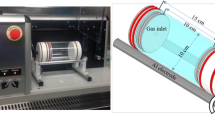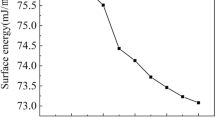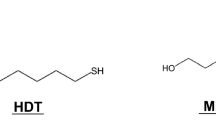Abstract
A NH3 plasma process has been studied for enhancing the adhesion of aluminum coatings on polyethyleneterephtalate (PET) films. According to our peel strength results, NH3 plasmas increase markedly the adhesion of aluminum on PET compared to O2 discharges, with a much shorter treatment time. A tentative model of nonhindered growth of Al-coating based on the Lewis basic character of the functionalities grafted by NH3 plasma is proposed for Al-polymer interactions, and for explaining the various steps in the process. The effects of power input and treatment time on the polymer surface chemistry and on the metal-polymer peel strength have been evaluated. Treatment times as short as 0.1 s at 100 W proved to be the best conditions in NH3 plasmas, for a significant increase in Al/PET adhesion, while longer treatments have a detrimental effect. This may explain why most authors have not discovered the benefits of NH3 plasmas for improving the adhesion of metals on PET, and have preferred O2 or air treatments. The relative basicity of PET grafted with N-containing functionalities has been measured by means of X-ray Photoelectron Spectroscopy (XPS) analysis of samples exposed to vapors of trichloromethane, a Lewis acid molecular probe. The Al/PET adhesion was evaluated by means of a 180° Peel Test.
Similar content being viewed by others
REFERENCES
K. L. Mittal, J. Vac. Sci. Technol. 13, 19 (1976).
F. Arefi-Khonsari, V. Andre, P. Montazer-Rahmati, and J. Amouroux, Pure Appl. Chem. 64, 715 (1992).
F. Arefi-Khonsari, M. Tatoulian, N. Shahidzadeh, and J. Amouroux, in Plasma Processing of Polymers, R. d'Agostino, P. Favia, F. Fracassi, eds., NATO ASI Series E, Vol. 346, Kluwer, Dordrecht (1997).
N. Shahidzadeh, M. M. Chehimi, F. Arefi-Khonsari, J. Amouroux, and M. Delamar, Plasmas and Polymers 1, 27 (1996), and references therein.
E. M. Liston, L. Martinu, and M. R. Wertheimer, in Plasma Surface Modification of Polymers: Relevance to Adhesion, M. Strobel, C. S. Lyons, and K. L. Mittal, eds., VSP (1994).
C. Y. Kim, J. Evans, and D. A. I. Goring, J. Polym. Sci. 15, 1365 (1971).
J. M. Pochan, L. J. Gerenser, and J. F. Elman, Polymers 27, 1058 (1986).
S. Sapieha, M. Verreault, J. E. Klemberg-Sapieha, E. Sacher, and M. R. Wertheimer, Appl. Surf. Sci. 44, 165 (1990).
L. J. Gerenser, J. Vac. Sci. Technol. A 6, 3682 (1990).
M. Bou, J. M. Martin, Th. LeMogne, and L. Vovelle, Appl. Surf. Sci. 47, 149 (1991).
Quoc Toan Le, J. J. Pireaux, and J. J. Verbist, Surf. Interface Anal. 22, 224 (1994).
Quoc Toan Le, M. Chtaib, J. J. Pireaux, and R. Caudano, in Polymer-Solid Interfaces, J. J. Pireaux, P. Bertrand, and J. L. Brédas, eds., Hilger Publisher, London (1992).
P. Favia, M. V. Stendardo, and R. d'Agostino, Plasmas Polymers 1, 91 (1996).
P. Favia, F. Palumbo, M. V. Stendardo, and R. d'Agostino, in Surface Modification of Polymeric Biomaterials, B. D. Ratner and D. G. Castner, eds., Plenum Press (1996).
J. M. Grace, D. R. Freeman, R. Corts, and W. Kosel, J. Vac. Sci. Technol. A14 (1996).
B. Chapman, Glow Discharges Processes; J. Wiley, New York (1980).
G. Cicala, M. Creatore, P. Favia, R. Lamendola, and R. d'Agostino, Appl. Phys. Letters 75, 37 (1999).
R. Lamendola, E. Matarrese, M. Creatore, P. Favia, and R. d'Agostino, in Plasma Deposition and Treatment of Polymers,W.W. Lee, R. d'Agostino, and M. R.Wertheimer, eds., MRS Symp. Proc., Vol. 544, (1999).
F. Palumbo, P. Favia, A. Rinaldi, M. Vulpio, and R. d'Agostino, Plasmas and Polymers 4, 133 (1999).
E. Matarrese, R. Lamendola, and R. d'Agostino, Proc. 14th Int. Symp. Plasma Chemistry, ISPC-14, Prague (CZK), 1227 (1999).
H. Schonhorn, J. Polymer Sci. A1, 3523 (1963).
K. L. Mittal, in Adhesion Measurement of Thin Films, Thick Films and Bulk Coatings, K. L. Mittal, ed., ASTM STP 640, (1978).
J. L. Gardon, J. Appl. Polym. Sci. 7, 643 (1963).
G. Beamson and D. Briggs, High Resolution XPS of Organic Polymers; the Scienta ESCA 3000 Database, John Wiley, New York. 202 (1992).
M. M. Chehimi, E. Pigois-Landureau, M. Delamar, J. F. Watts, S. N. Jenkins, and E. M. Gibson, Bull. Soc. Chim. Fr. 129, 137 (1992).
M. M. Chehimi, J. F. Watts, W. K. Eldred, K. Fraoua, and M. Simon, J. Mat. Chem. 4, 305 (1994).
L. J. Gerenser, in Plasma Surface Modification of Polymers: Relevance to Adhesion, M. Strobel, C. S. Lyons, and K. L. Mittal, eds., VSP (1994).
R. d'Agostino, F. Cramarossa, S. De Benedictis, and G. Ferraro, Plasma Chem. Plasma Proc. 1, 365 (1981).
J. Kurdi, M. Creatore, P. Favia, R. d'Agostino, and F. Arefi-Khonsari, unpublished results.
Author information
Authors and Affiliations
Rights and permissions
About this article
Cite this article
Creatore, M., Favia, P., Tenuto, G. et al. NH3 Plasma Treatments of PET for Enhancing Aluminum Adhesion. Plasmas and Polymers 5, 201–218 (2000). https://doi.org/10.1023/A:1011306118263
Issue Date:
DOI: https://doi.org/10.1023/A:1011306118263




